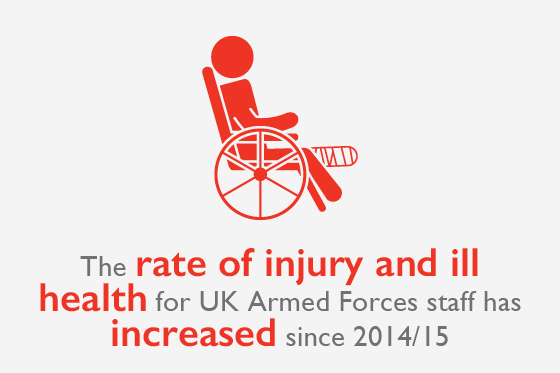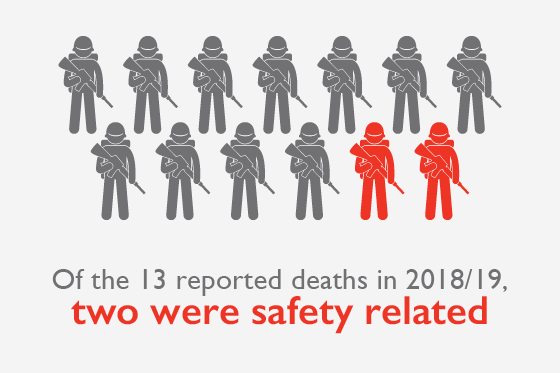We all know that military service is a high-risk and sometimes dangerous job – but how many military personnel are actually hurt during service in the UK armed forces?
In this guide, we’ll explore common military injuries, as well as statistics around injury and illness in the British Army, Royal Air Force and Royal Navy.
The most common military injuries in the UK armed forces
The most common military injuries include:
- Injuries from training exercises
- Injuries on the battlefield
- Blast or firearm injuries
- Collisions involving military vehicles
- Injuries caused by military equipment
- Cold weather injuries, including hypothermia and frostbite
- Hot weather injuries
- Musculoskeletal injuries
- Falls from height and crush injuries
- Hearing loss and tinnitus
- Post-traumatic stress disorder (PTSD).
The rate of injury and ill health reported in the military has increased



From 2014/15 to 2018/19, the rate of injury and ill health reported in the UK Armed Forces increased.
Although the number of incidents has stayed much the same, the number of people in the Armed Forces has decreased.
As a result, the rate of injury and ill health reported has increased from 35 incidents per 1,000 personnel, to 40 incidents per 1,000 personnel.
There were two safety-related deaths in 2018/19


From 2014/15 to 2018/19, there were 341 armed forces deaths, with 23 of those deemed safety related. Aircraft accidents accounted for 39% of the safety-related deaths.
Of the 14 deaths which occurred in 2018/19, two were due to issues with health and safety.
One of these involved land transport and the other occurred during a diving exercise.
There were almost 22,000 health and safety incidents reported in 2018/19

In 2018/19, there were 21,975 health and safety incidents reported to the MoD.
Almost 14,000 of the incidents reported led to someone being injured, while a further 360 led to ill health.
Of all reported health and safety incidents, 35% are a near miss or dangerous occurrence

A near miss is a health and safety related incident that did not result in injury or illness, but had the potential to cause death, injury or ill health if it was not addressed. Examples of this could include damaged equipment or a slip or trip hazard.
A dangerous occurrence is a specific, reportable adverse event as defined in Schedule 2 of the Reporting of Injuries, Diseases and Dangerous Occurrences Regulations (RIDDOR). Examples include fire and explosions caused by electrical accidents, failure of breathing apparatus (such as diving equipment) and the collapse of scaffolding.
The most frequent cause of a near miss or dangerous occurrence for the MoD is an issue with equipment.
Of all injuries reported to the MoD, 55% occur during training

Over half of all injuries occur during training, with physical training and adventure training being the cause of the vast majority of training injuries.
Of those injuries, 35% affect the lower body (foot, leg, ankle, knee or hip).
The rate of injury is higher for untrained personnel

Untrained personnel comprise army personnel who have yet to complete Phase 1 training, and naval service and RAF personnel who have yet to complete Phase 2 training.
In the army, untrained personnel experience almost double the rate of health and safety related injuries and illnesses in comparison to their trained counterparts. The difference is even greater in the navy and RAF, where untrained personnel are nearly three times more likely to suffer a health and safety related injury or illness.
*Statistics from Ministry of Defence Annual Summary & Trends Over Time 2014/15 – 2018/19 (Revised 22 September 2020)
